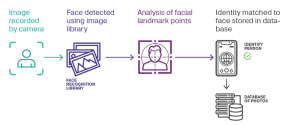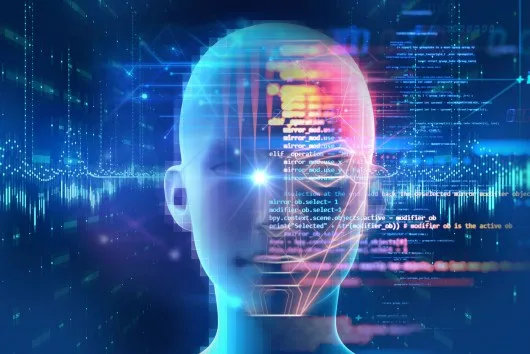In today’s data-driven world, the risk of cyber theft has never been higher. Protecting sensitive personal information from malicious attacks is a pressing concern, and traditional security measures are often insufficient. From identity fraud to unauthorized access, the stakes are high. This is where facial recognition software steps in, offering a powerful solution to enhance data security.
Why Facial Recognition Matters
Facial recognition technology, a subfield of artificial intelligence (AI), can identify individuals by analyzing facial features from images or videos. It then cross-references this data with a database of recognized faces to find a match. This technology, once a sci-fi fantasy, is now a staple in various applications, from smartphones to security cameras at public events.
According to Statista, the global facial recognition market is projected to reach $4.94 billion in 2024 and surpass $8.44 billion by 2030, growing at a compound annual growth rate (CAGR) of 9.34%. The increasing demand for enhanced security solutions underscores the significance of facial recognition technology.
The Benefits of Facial Recognition Software
Facial recognition systems offer numerous advantages that are transforming industries and improving daily life. Here are some key benefits:
Enhanced Security
Facial recognition software provides robust security by identifying suspicious behaviors, verifying identities, and securing digital devices. It ensures safety in crowded places and adds a layer of protection in healthcare, banking, and retail services by allowing only authorized individuals to access restricted areas or sensitive information.
Fraud Prevention
Facial recognition software is a powerful tool against identity theft and fraud. By verifying identities through unique facial features that are difficult to replicate, businesses, especially financial institutions, can significantly reduce fraudulent activities such as account takeovers and unauthorized transactions.
Quick and Convenient
Facial recognition technology simplifies access to services by replacing traditional authentication methods. Imagine bypassing long queues at airports or events with just a quick facial scan. This technology promotes digital-first experiences, speeding up procedures and enhancing user convenience.
Personalized Customer Experience
Businesses use facial recognition to provide customized services and recommendations based on customer history and preferences. Retail stores, for instance, can analyze customer reactions to optimize layouts and marketing strategies, leading to improved customer satisfaction.
Accessibility
Facial recognition technology enhances accessibility for individuals with disabilities. It allows users to unlock devices or access facilities without physical interaction, improving independence and inclusivity.
Improved Public Safety
Law enforcement agencies use facial recognition to identify suspects or missing persons from surveillance systems. This technology enables quicker response times and more effective crime prevention strategies, contributing to safer communities.
Operational Efficiency
Facial recognition software can streamline internal processes such as employee attendance tracking and monitoring movements in restricted areas, enhancing operational efficiency and accountability.
How Facial Recognition Software Works

Facial recognition software follows a systematic workflow:
- Face Detection: AI algorithms detect and locate human faces in images or video frames.
- Face Alignment: The software normalizes and aligns facial data despite variations in lighting and angles.
- Feature Extraction: Unique facial features are converted into a mathematical representation called a face template.
- Face Matching: The system compares the face template against a database to find a match.
- Face Verification: Based on comparison results, the software decides whether the face matches any in the database.
Applications Across Industries
Facial recognition technology is revolutionizing operations across various sectors:
- Healthcare: Enhancing patient care and operational efficiency.
- Retail and eCommerce: Reducing retail crimes and enhancing security.
- Government: Preventing public welfare fraud and enhancing public safety.
- Law Enforcement: Identifying suspects and missing persons.
- Banking and Finance: Reinforcing security and preventing fraud.
- Aviation: Streamlining the boarding process.
- Education: Automating attendance tracking and personalizing learning experiences.
- Telecom: Securing smartphones with biometric facial recognition.
Real-World Examples
Several big brands are leveraging facial recognition technology:
- Apple: Uses Face ID to unlock iPhones and authorize payments.
- Facebook: Identifies and tags users in photos and videos.
- Google: Enhances photo tagging and secure logins on Android devices.
- Delta Air Lines: Streamlines the boarding process with facial scans.
- Uber: Verifies drivers’ identities for passenger safety.
Developing Facial Recognition Software: A Step-by-Step Process
Creating facial recognition software involves several steps:
- Requirement Analysis: Identify specific business needs and objectives.
- Data Collection: Gather a diverse dataset of facial images.
- Data Preprocessing: Normalize and enhance image quality.
- UI/UX Design: Design a user-friendly interface.
- Development: Build the software infrastructure and integrate algorithms.
- Privacy and Security: Implement robust security measures and comply with data protection laws.
- Model Training: Use deep learning techniques to train the model.
- Testing and Validation: Ensure performance, accuracy, and robustness.
- Deployment: Integrate the system with existing infrastructure.
- Monitoring and Maintenance: Regularly update and maintain the system.
Cost and Timeline
The cost of developing facial recognition software varies based on system complexity and required features. On average, it ranges from $30,000 to $300,000 or more. The development timeline can range from four months to a year, depending on the project’s scope and complexity.
Challenges and Solutions
Despite its benefits, facial recognition technology poses challenges such as bias, ethical concerns, and privacy breaches. Addressing these challenges involves:
- Bias and Inaccuracy: Use diverse datasets and regularly update algorithms.
- Ethical Concerns: Establish clear ethical guidelines and legal frameworks.
- Privacy Breach: Implement stringent data protection policies.
Partner with TechDotBit for Your AI Needs
Facial recognition technology offers a powerful defense against identity theft and enhances security across various industries. Beyond security, it also improves user experiences, optimizes customer service, and enhances operational efficiency.
At TechDotBit, our AI experts have extensive knowledge and a proven track record of delivering successful AI-driven projects. Whether you want to develop facial recognition software or need AI consulting services, we are here to help.
Contact us to discuss your project and get a detailed quotation. Let’s work together to elevate your business and secure your data with advanced facial recognition technology.
FAQs
Q: How much does facial recognition software development cost?
A: The cost typically ranges from $30,000 to $300,000 or more, depending on specific business needs.
Q: How long does it take to build facial recognition software?
A: Development can take four months to a year, depending on project scope and complexity.
Q: What are some must-have facial recognition software features?
A: Essential features include accuracy, security, liveness detection, scalability, and integration capabilities.
Q: How accurate is facial recognition software?
A: Accuracy varies, but state-of-the-art systems can achieve near-perfect accuracy with proper algorithms and datasets.








